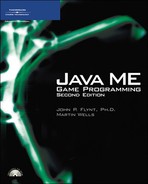Book Description
Get ready to create your own J2ME game! This updated edition to the popular J2ME Game Programming provides updated sofware coverage as well as updates to the programming approaches specific to Java ME software. It also covers the recent innovations in mobile games with relations to iPods and cell phones. You will learn the essentials of J2ME game development from the ground up. Throughout the book you will discover the issues involved in developing for multiple target devices and how to work through the jungle of device-specific libraries and device capabilities. Working on a limited platform it is important to squeeze as much as you can out of those precious bytes, so in this book you will find the tools and source code you need to get the most out of the constrained resources. You will also learn how to structure your code and classes to achieve as small an application footprint as possible. As you work toward developing your own J2ME game, you'll examine the game lifecycle, how to handle resources, various methods of drawing to the screen, optimizing memory usage, handling the users input, and even sharing high-scores online! Previous experience in programming object-oriented languages and a basic level of math skills is recommended.
Table of Contents
- Copyright
- Acknowledgments
- About the Authors
- About This Book
- Mobile Device Fundamentals
- Setting Up for Development
- Text-Oriented Activities
- Using Graphics
- Game Orientation
- Scrolling Background
